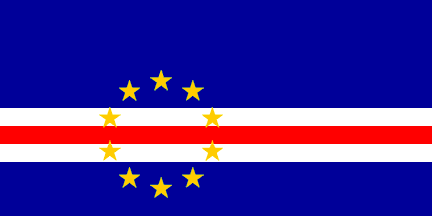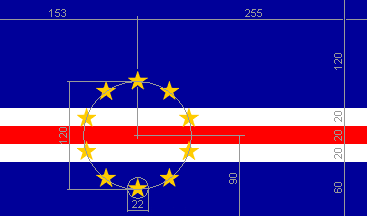
image by Željko Heimer, 20 Jan 2005 | :?

Last modified: 2025-11-01 by antónio martins
Keywords: law | ratio: ambiguous | construction |
Links: FOTW homepage |
search |
disclaimer and copyright |
write us |
mirrors

image by Željko Heimer, 20 Jan 2005 |
:?
The Constitution of the Republic of Cabo Verde (Green Cape Islands), adopted in 1992, defines under its Article 8th the new flag, very different from the previous (which was similar to the Bissau-Guinea flag, for historical reasons), and said by some to be very “unafrican”.
2. The National Flag is made up of five rectangles stacked along its length.
- The upper and lower rectangles are blue, being the upper one half of the flag area and the lower one forth.
- Separating the two blue rectangles, three stripes each being one 12th of the flag area.
- The stripes adjoining the blue rectangles are white and the one between is red.
- Over the five rectangles, ten yellow five pointed stars, with the upper apex in the 90 degree position, define a circle which center lies in the intersection of the middle line of the second vertical quarter, counted from the left with the middle line of the second horizontal quarter, counted from the lower edge. The star nearer from this edge is set inside an invisible circle which center lies on the middle line of the lower blue stripe.
Confused? Good — the original is also very “unclear”, to say the least. I’ll try a more clear and concise description:
Over a field of horizontal unequal stripes (from the top: blue, 6 twelfths of the flag’s height; white, 1 twelfth of the flag’s height; red, 1 twelfth of the flag’s height, white, 1 twelfth of the flag’s height; blue, 3 twelfths of the flag’s height), a circle of ten yellow five-pointed stars pointing upwards, with radius of 1/4 of the flag’s height and center 3/8 of the flag’s width from the hoist and 3/8 of the flag’s height from the bottom edge.(Stars’ sizes not specified, neither are the color shades.)
António Martins, 19 May 1997 and 29 March 2002
The constitutional text is a bit wordy and a bit
fuzzy, but still fairly well defined, I’d say. The biggest omission
seems to be that the size of the stars is not defined.
The other unmentioned measurement is the ratio, and
that may certainly be intentional.
Peter Hans van den Muijzenberg, 27 January 2014
I’d call this legal description “cleverly undefined”,
if I could think of any advantage to have a flag’s ratio (and the
stars’ sizes) undefined on purpose. Lacking one, I’d go
with ivory-tower intellectualism, applying to a flag description terms and
methods that make sense in a different discipline (no idea which though
— architecture?, surveying?, graphic design?, high school
Geometry?).
António Martins, 26 May 2017
CONSTITUIÇÃO DA REPÚBLICA
Lei Constitucional n.º 1/V/99 de 23 de NovembroPARTE I
PRINCÍPIOS FUNDAMENTAISTÍTULO I
»(…)«
DA REPÚBLICAArtigo 8º
(Símbolos nacionais)»(…)«
- A Bandeira Nacional é constituída por cinco rectângulos dispostos no sentido do comprimento e sobrepostos.
- Os rectângulos superior e inferior são de cor azul, ocupando o superior uma superfície igual a metade da bandeira e o inferior um quarto.
- Separando os dois rectângulos azuis, existem três faixas, cada uma com a superfície igual a um duodécimo da área da Bandeira.
- As faixas adjacentes aos rectângulos azuis são de cor branca e a que fica entre estas é de cor vermelha.
- Sobre os cinco rectângulos, dez estrelas amarelas de cinco pontas, com o vértice superior na posição dos noventa graus, definem um círculo cujo centro se situa na intersecção da mediana do segundo quarto vertical a contar da esquerda com a mediana do segundo quarto horizontal a contar do bordo inferior. A estrela mais próxima deste bordo está inscrita numa circunferência invisível cujo centro fica sobre a mediana da faixa azul inferior.
»(…)«
- The National Flag consists of five rectangles placed lengthwise and stacked.
- The upper and lower rectangles are of the colour blue, with the upper occupying an area equal to half of the flag and the lower a quarter.
- Separating the two blue rectangles are three bands, each one with an area equal to a twelfth of the area of the flag.
- The bands adjacent to the blue rectangles are of the colour white and the one lying between them is of the colour red.
- Over the five rectangles, ten yellow five-pointed stars, with their upper point on a heading of ninety degrees, define a circle of which the centre is located on the intersection of the centre line of the second vertical quarter, counting from the left, with the centre line of the second horizontal quarter, counting from the lower edge. The star closest to that edge is circumscribed by an invisible circumference of which the centre lies on the centre line of the lower blue band.
quoted and translated by Peter Hans van den Muijzenberg, 27 January 2014
It seems that the 1999 Constitution is unchanged from the 1992 one in
what concerns the flag — is’t even the same article number
(8th).
António Martins, 26 May 2017
Note that the constitutional description only refers
to areas and heights and uses independent horizontal and vertical
measurements; that means that no fixed proportions are specified —
such a description could apply to a 1:2, 2:3, 1:1 or most other flag
formats!
António Martins, 19 May 1997

image by Željko Heimer and
António Martins, 20 Jan 2005
This was also the case of the previous flag:
The Constitutions of both Cape Verde and
Bissau-Guinea prescribed «three equal area
rectangles, one vertical to the hoist and two horizontal to the fly»,
but Cape Verde had a 2:3 flag (each rectangle being 1×2) and
Bissau-Guinea had a 1:2 flag (vertical rectangle 6×4 and horizontal
rectangles 3×8).
António Martins, 19 May 1997

image by Željko Heimer, 29 Jan 2005
I have a specification by William Crampton,
which refers to a diagram and regulations issued at the time of adoption,
and the copy of a diagram which matches this, but, no actual confirmation
that this is actually the diagram to which he referred, and there was,
regrettably, no copy of the “regulations” as such on file. To
make matters even more uncertain, this gives us a third
ratio of 10:17. Whilst I had (and have) the greatest respect for
William’s professionalism, I have none the less attempted to get
some sort of official confirmation, but (as you would expect) without
result.
Christopher Southworth, 20 Jan 2005
As per Crampton’s document Christopher cited: overall ratio
1000:1700, measured along hoist 250+83+83+83+500, along length 638+1062,
stars arranged on a circle of diameter 470 each inscribed in a circle with
diameter 91.
Željko Heimer, 29 Jan 2005
The details of the (unfortunately) unconfirmed specification I have are as follows:
On a flag of 1000×1700 units, the fly is given as 500-83-83-83-250, the distance to the centre of the imaginary circle which places the stars is given as 638 along the length and 275 up from the base, the diameter of that circle is given as 470, with each star contained within an imaginary circle of diameter equalling 91.
There are two slight problems [later fixed] with this when set against the prescriptions of the Constitution:
The figure of 638 is from the hoist to the centre point of the imaginary circle around which the stars are arranged, and almost exactly represents the Constitutional requirement of three-eighths the length (the exact figure on a flag of 1700 units long would be 237.5)? The widths given for the various stripes are indeed clumsy (and as I pointed out previously slightly inaccurate), but this could well be due to somebody — and we hope it was somebody official — having measured an actual flag, but they are (in any case) close enough to the legal stipulation of one-twelfth each for the narrow stripes.
A size of 1000×1700 units is hardly what I, or an other
experienced vexillologist, would choose for a flag whose legal
requirements include 3/8, 1/2 and 1/12, but that is what the diagram uses.
I must agree that a flag 240 units wide (and if we accept 10:17) 408 units
long would be far more sensible, and would give fly measurements of
120-20-20-20-60.
Christopher Southworth, 28 Jan 2005

image by Željko Heimer, 29 Jan 2005
As per Crampton’s document Christopher
cited the circle of stars is too small in accordance with the
(constitutional) requirement that the lowest
star should be in the middle of the blue stripe. This would be
achieved if the diameter would be 500. (In the image above, figures
reduced to 25/6 to achieve reasonable and yet exact numbers.)
Željko Heimer, 29 Jan 2005
Unless any of the authors above can give a source for those values
(which I doubt, considering their disparity), I believe that they are not
the ratio(s) prescribed by a lesser and more detailed law, but rather
(mis)measurements of real flags, manufactured under the legal license of
no fixed ratio.
António Martins, 24 Jan 2001
The size of the stars is also not mentioned in the
Constitution. As all the images I have seen show the
stars somewhat “entering” the red stripe, they must be
inscribed in circles with diameter larger than exactly 1/12 of the
flag’s height, perhaps 1/10 of the flag’s height.
Željko Heimer, 28 Apr 2001
![[flag]](../images/c/cv'pms.gif)
image by Zoltan Horvath, 29 Apr 2024
The colours of the flag and the coat of arms of Cabo Verde were specified in the Graphic Design Manual (Manual de Normas Gráficas), which was adopted by Government Resolution 37/2009 of 21 December 2009. The Manual was published in Boletim oficial, I. Série 48 of 21 December 2009. The colours according the Pantone colour scheme are defined as:
There is a Government Resolution 37/2009 of 21 December 2009 (Graphic Design Manual – Manual de Normas Gráficas), where the colors in Pantone color scheme are defined as:
The protocol manual for the London 2012 Olympics
[loc12], with info approved by each
NOC, gives for Cape Verde
PMS 293 blue, 032 red, 109 yellow.
Ian Sumner, 10 Oct 2012
I just saw on a large photo taken outside the City Hall of
São Filipe (Fogo island) the national flag
of Cape Verde. The stars are clearly Y+, “dark” yellow
(![]() ), with clear contrast on the white areas.
), with clear contrast on the white areas.
António Martins, 30 Nov 2003
Anything below this line was not added by the editor of this page.